COVID-19 in Canada: 'Alarming' projection of virus shows Ontario on track to 'worsen', could see 6,500 cases daily by end of year
For more on today’s top stories and the spread of the novel coronavirus across the country, please refer to our live updates below throughout the day, as well as our COVID-19 news hub.
Ontario could see 6,500 daily COVID-19 cases before the end of the year
Ontario released “alarming” COVID-19 projections for the province, which indicate that the pandemic situation continues to worsen, with case numbers expected to exceed a number of European jurisdictions, currently in various forms of lockdown.

“Key indicators of the pandemic continue to worsen and although the impact varies widely across regions of the province, most indicators are moving in a worsening direction across the entire province,” Dr. Adalsteinn Brown, co-chair of Ontario's COVID-19 science advisory table said Thursday. “If we continue on with the current level of restrictions I would not expect to see a deviation from the current results, you would continue to see growth.”
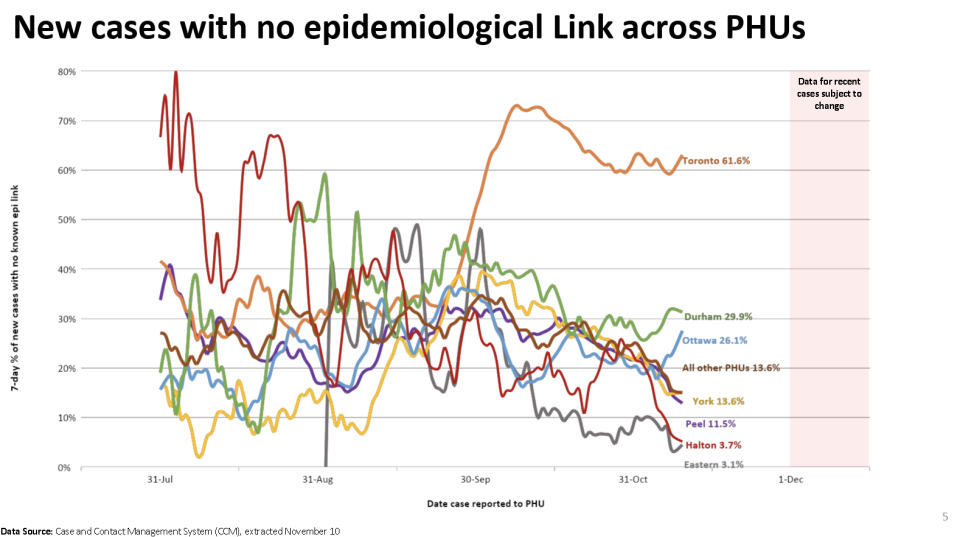
“We are starting to not have the ability to track all of our cases, in some public heath units that’s quite acute, which means that we are in very clearly a second wave of the pandemic,” Dr. Brown said.

There is also a “high level” of COVID-19 cases with no epidemiological link across some public health units. Dr. Brown indicated there are several factors that contribute to these high values, including community spread of the virus.
“As community spread increases, the number of cases where it’s hard to identity the source of that case increases,” he said. “Second, as the number of cases get to a certain level, it’s very hard to track all of those cases and priorities must be placed on tracking the...most critical cases.”
Dr. Brown also indicated that “some issues of changing systems” are at play here.

Younger individuals usually require “very little” hospital use but COVID-19 continues to grow in older age groups now, tripling or quadrupling in some cases.
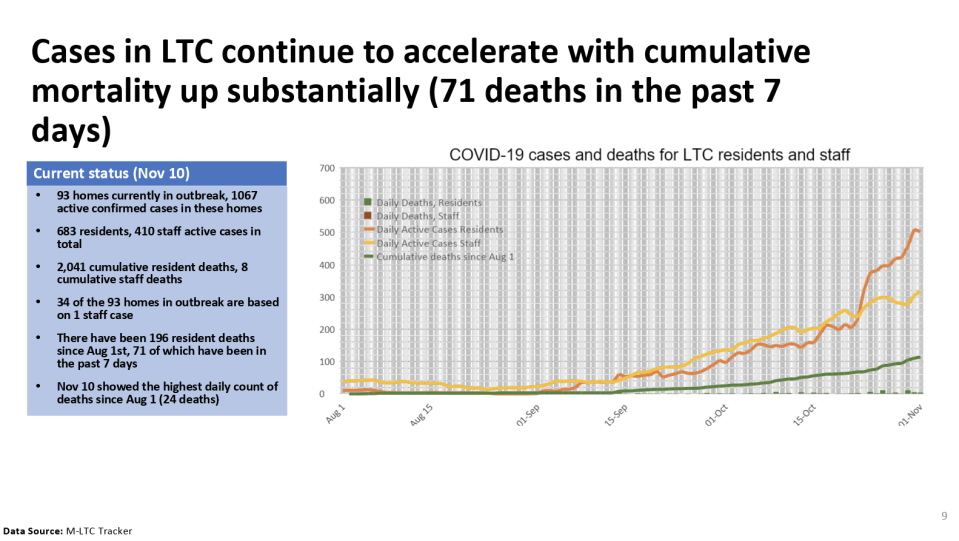
“This is very challenging and dangerous news for the health system,” Dr. Brown said. “If this spillover [continues] you will see growing hospitalization rates….and you will see mortality climbing.”
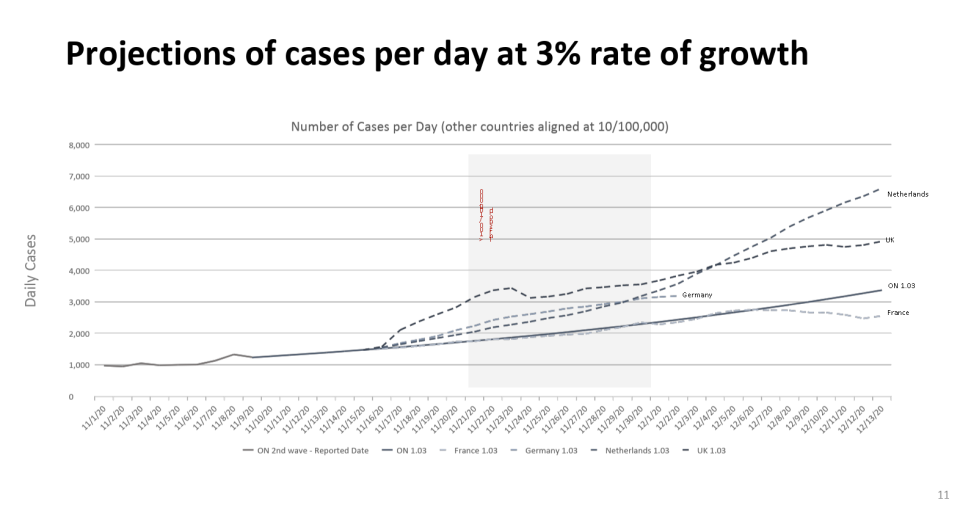
Dr. Brown indicated that Ontario is now at about a six per cent rate of growth over the last three days, and four per cent over the past seven days, but even at three per cent, the province will exceed the French COVID-19 situation, with more than 3,000 daily cases by mid-December.

The co-chair of Ontario's COVID-19 science advisory table said even a five per cent growth rate scenario may be “optimistic,” and would put the province in a position of having more COVID-19 than France, Germany and the UK by mid-December with about 6,500 cases per day.
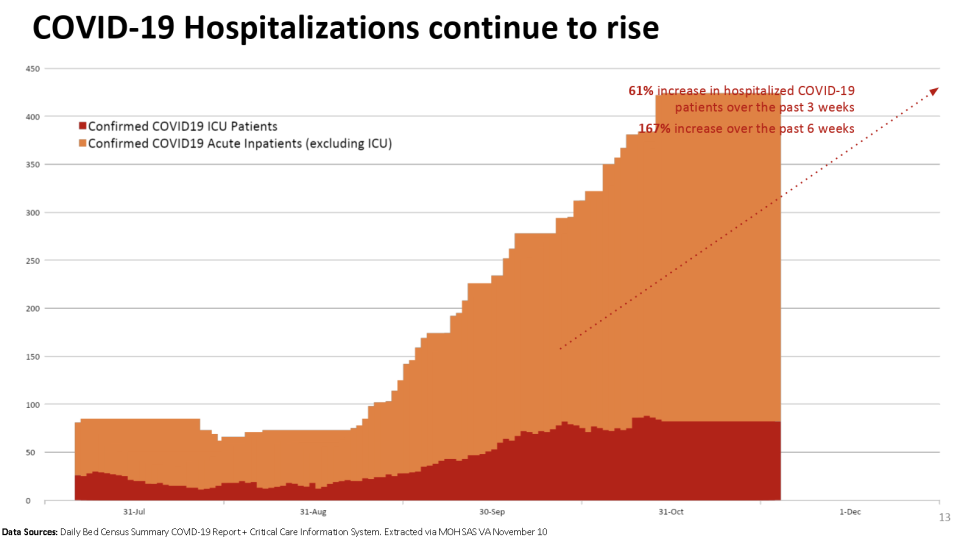
Dr. Brown explained Ontario is still seeing a “relatively low” number of hospitalizations compared to the total number of beds in the province, but provincial hospitals run “very close to capacity” at all times.

“Particularly given the access to care deficit that built up in the first wave, this makes it very challenging to actually get caught up and provide people with the care that they need,” he said.
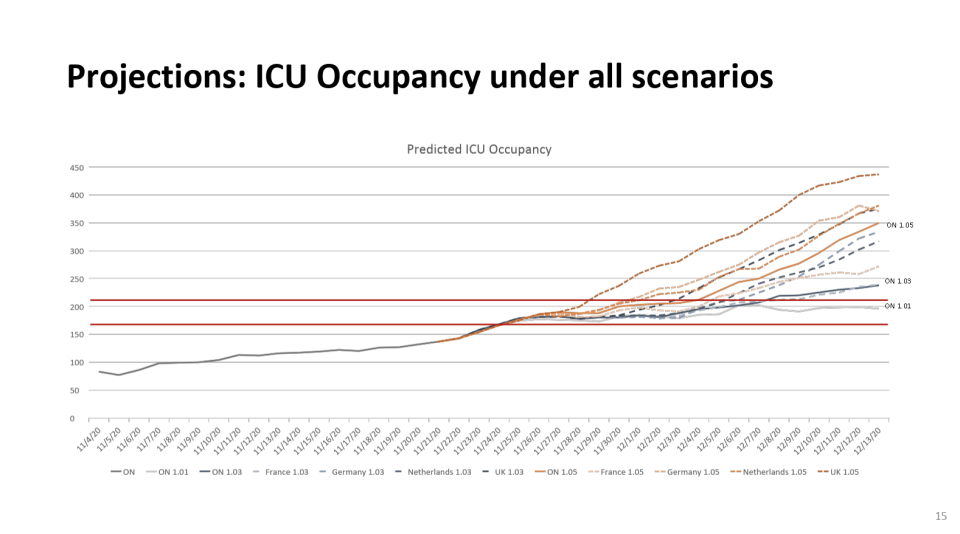
The latest modelling data indicates ICU occupancy will exceed 150 beds across the province.
“This threshold of 150 beds is an important threshold because it’s that point at which we need to start cancelling planned surgeries,” Dr. Brown said.
Wastewater analysis shows the impact of public health measures
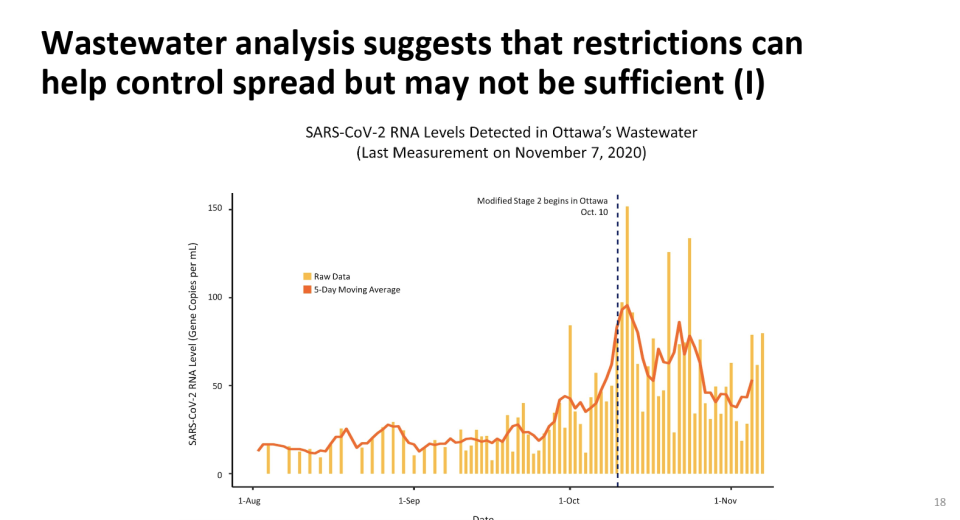
The wastewater tracking suggests that the the restrictions introduced by the province did impact COVID-19, which Dr. Brown indicated could have been worse than the current surge.
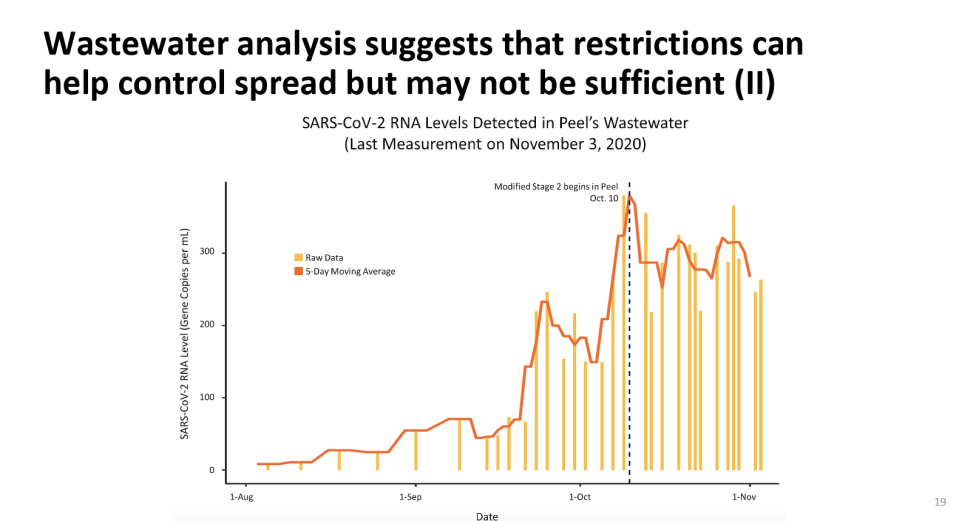
Both the Ottawa and Peel wastewater analysis show a significant decline in SARS-CoV-2 RNA level after both regions were moved into modified Stage 2 restrictions.
Could more restrictions be coming?
Dr. Dirk Huyer, coordinator of the provincial outbreak response, indicated outbreaks continue to make up about 10 per cent of cases. Out of 29 recent outbreaks, 18 are from vulnerable setting and schools, six are from the public-facing sector and five are in workplaces.
In the past week, there has been a 57 per cent increase in outbreaks, and more than 632 outbreaks over the past 30 days.
“It speaks specifically to the importance of recognizing the transmission within social settings, those social settings may be within a home setting, it may be within gatherings that people get together in or it may be a social settings outside of the home location,” Dr. Hyer said. “It’s people bringing the infection into that social setting and that may be where the outbreak is identified.”
He added that some people have also gone to a workplace with symptoms and gathered together after work.
Dr. David Williams, Ontario’s chief medical officer of health, called the latest modelling data “alarming” and indicated that Ontarians are having “too much” contact with others.
He indicated that the provincial health table is still working on making a determination on whether additional measures need to be introduced across the whole province, or even in certain areas of the province.
When asked if there should be more restrictions in place in some of the COVID-19 hotspots, Dr. Brown said, “if the goal is to reduce the number of cases and the goal is to reduce the impact on the health system, then yes.”
“The later that one intervenes in the epidemic curve, the harder it is to get the case growth under control,” he said.
Ontario premier defends ‘balanced’ approach to battling COVID-19
At a press conference on Thursday, Ontario Premier Doug Ford said he is “disappointed” about reports of people and businesses not following the COVID-19 rules in the province.
For example, two weddings that took place in late October, in Vaughan, Ont., have been linked to at least 17 confirmed COVID-19 cases.
Ontario NDP Leader Andrea Horwath is calling for a “circuit-breaker-style” program for COVID-19 hotspots in the province.
The NDP leader wants the provincial government to pay businesses to go into a “targeted two-week modified Stage 1” to break the chains of transmission.
“Step one of saving people’s jobs and the economy is crushing the virus,” a statement from Horwath reads. “Doug Ford is cancelling public health protections too fast.
“He’s putting people’s lives and health at risk under the false pretense that it helps businesses.”
Ford commented on Horwath’s request and said the Ontario Conservative government is taking a more “balanced” approach to managing COVID-19.
“It’s easy for people to shut everything down when they’re guaranteed a pay cheque every single week,” Ford said.
The Ontario premier was also asked about a Toronto Star story, which states that the provincial government “rejected” its own public health advice when it moved to the colour-coded framework.
Ford called the report “totally inaccurate” and stressed that Dr. David Williams, Ontario’s chief medical officer of health, approved the framework.
Ontario breaks another record for daily COVID-19 cases
Ontario reported 1,575 cases of COVID-19 on Thursday, including 472 new cases in Toronto, 448 in Peel, 155 in York Region and 91 in Ottawa.
Another 18 deaths were reported, bringing the total in the province to 3,293.
There were 39,559 tests completed in the previous day, with 41,977 tests under investigation.
Currently, 431 people with COVID-19 are in Ontario hospitals, including 98 in ICU.
There are now 94 long-term care homes that have declared an outbreak, which includes 695 resident cases and 435 staff cases.
Ontario reported 103 new school-related COVID-19 cases in schools, including 51 student cases, 14 staff cases and 38 individuals who have not been identified.
Quebec confirms 42 more COVID-19 deaths
Quebec reported 1,365 new COVID-19 cases on Thursday, including 325 cases in Montreal, 197 cases in Saguenay – Lac-Saint-Jean and 172 cases in Montérégie.
The province also confirmed 42 more deaths, including nine that occurred in the last 24 hours.
There are currently 583 people in Quebec hospitals, including 86 in intensive care.
Check out our COVID-19 in Canada topic page for latest news, tips, health updates, cases and more.

 Yahoo Finance
Yahoo Finance 
